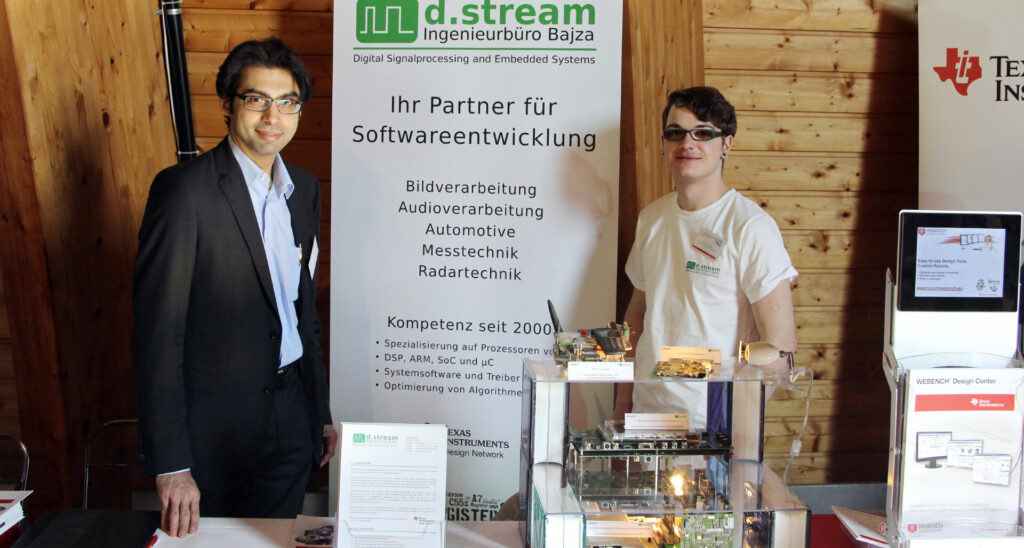
References
An excerpt of d.stream’s references
TIER-1 IN THE AUTOMOTIVE SECTOR
Camera Mirror System (CMS) for a Supercar:
Description:
Development of an innovative digital exterior mirror system (Camera Mirror System, CMS) for a supercar, featuring one external camera and one internal display on each side.
Project duration: 3 years
Services:
– Support of the customer’s development department in embedded software development
– Full project involvement from early development to series production, with up to five engineers from d.stream engineering
Development process:
– Implementation according to Automotive SPICE (ASPICE)
– Compliance with MISRA C, MISRA C++, and ASIL-B standards as per ISO 26262
Technology:
– Software framework development for the Texas Instruments TDA3 processor using TI-RTOS
Developed components:
– CSI-2 video capture driver
– Integration and configuration of video sensors and serializer/deserializer (LVDS)
– Integration and debugging of ISP software
– Lens Distortion Correction (LDC)
– Inter-process communication (IPC) across five cores
– CAN communication
– Various peripheral drivers (I2C, UART, QSPI)
– Display overlays and output
– Synchronization between capture and display
– Secure bootloader and firmware update via CAN
– Complete TDA3 initialization (clocks, memory, cache, MMU, etc.)
Collaboration:
– Close communication with the customer’s development team
– Tight cooperation with hardware engineers during prototype bring-up
– Efficient problem-solving through direct contact with Texas Instruments
TIER-1 IN THE AUTOMOTIVE SECTOR
Camera Mirror System (CMS) for a Truck:
Description:
Development of an innovative digital exterior mirror system (Camera Mirror System, CMS) for a truck, featuring two external cameras and one internal display on each side.
Project duration: 3 years
Services:
– Support of the customer’s development department in embedded software development
– Full project involvement from early development to series production, with up to five engineers from d.stream engineering
Development process:
– Implementation according to Automotive SPICE (ASPICE)
– Compliance with MISRA C, MISRA C++, and ASIL-B standards as per ISO 26262
Technology:
– Software framework development for the Texas Instruments TDA2p processor using TI-RTOS
Developed components:
– CSI-2 video capture driver
– Integration and configuration of video sensors and serializer/deserializer (LVDS)
– Integration and debugging of ISP software
– Lens Distortion Correction (LDC) & Image Stitching
– Inter-process communication (IPC) across eight cores
– CAN communication
– Various peripheral drivers (I2C, UART, QSPI)
– Display overlays and output
– Synchronization between capture and display
– Secure bootloader and firmware update via CAN
– Complete TDA2p initialization (clocks, memory, cache, MMU, etc.)
– Test system for image sensors (PC software / hardware)
Collaboration:
– Close communication with the customer’s development team
– Tight cooperation with hardware engineers during prototype bring-up
– Efficient problem-solving through direct contact with Texas Instruments
TAKATA AG
Driver assistance system:
Realization of a software framework for a multi-core processor from Texas Instruments with the real-time operation system SYS/BIOS. Development included components for IPC communication, peripheral drivers, video input and bootloader. The framework enables the costumer to integrate his own algorithms to the desired cores.

A COMPANY IN THE TRAFFIC MONITORING SECTOR
Runtime optimization of a tracking algorithm:
An already existing C++ algorithm on the DSP TI C6424 was optimized. The run time could be reduced to approx. 20% which prevented a new hardware development from the customer. Development also included the implementation of a USB transmission system using the FT232H-Converter on the DSP to transmit reference data and results faster, as well as a DSP/PC software for evaluating the algorithm with reference data.
DR. SCHWAB INSPECTION GMBH
Communications driver for a multi-DSP system:
The final device is used in production of blank CD/DVD discs for recognition of material or production errors with the help of different cameras and sensors. For fast image processing up to five TI C6414 DSPs are used which have to communicate with the host (PC). For this we created a communication driver for serial and parallel transmission of priority-based and packet-based command and video data between the DSPs and the PC. For a follow-up order we also implemented a bootloader for a software update and software for downloading applications from PC to the single DSPs.

A COMPANY IN BERLIN
Audio multi-room system:
During this projects the hardware setup was accomplished and system and application software for a 16 bit DSP, as well as a 8 bit Microcontroller were realized. The following functions were implemented for the DSP: Network I/O, audio output, infrared code receiption and audio sound settings (bass, middle, treble). The following functions were implemented for the Microcontroller: Transmission and learning of infrared codes over GPIO, display control over RS232, button query and various control tasks.
For a follow-up order a serial, bi-directional and bus-capable communications interface between DSP and Microcontroller was implemented. This interface transmits data over two GPIO wires and supports collision handling.
FUNKWERK KÖPENICK GMBH, A SUBSIDIARY OF DETEWE
Optimization of a TETRA vocoder
Creation of a scope statement for the optimization of an existing TETRA-Vocoder software, that is used in a trunked radio system device. This consits of Assembler source code that was ported from a TI-C54xx to a TI-C5510. This porting was originally not done completely and still contained errors. Following this, the order was given to d.stream and the source code optimization was done according to the scope statement. Reference of the project lead of Funkwerk Köpenick GmbH, from 30.11.04 (translated from German):
“ […] Mr. Bajza has fulfilled his tasks independently, in time and with great professionality to our complete satisfaction. Because of his commitment the Vocoder’s run time could be reduced by 50% and the general stability of our application could be improved.”

A COMPANY IN THE IMAGE PROCESSING SECTOR
Smart camera system:
In this project a C6713 from TI was used. The DSP software was optimized for a firmware update which also included the integration of the TCP/IP stack of d.SignT. This created the possibility to control and update the firmware of the smart camera via TCP/IP or UDP. Additionally d.stream provided support for the customer and his clients.
For this project a webserver and a web front end for controlling and visualizing the camera was also implemented.
A COMPANY FROM SWITZERLAND
Active noise cancelling system (ANC):
Software development for a Multi-DSP system with three C6727 from TI including extension and optimization of Inter-DSP communication, as well as the creation, optimization and simulation of the ANC algorithms.
A COMPANY IN BERLIN
Infrared camera with MPEG recording on MMC:
Realisation of a video recording system with a Blackfin BF533 DSP from Analog Devices. The video data was coded in MPEG format and saved on a MMC memory card. Inside the project the system and driver programming was implemented which consisted of: state machine, user interface, bettery surveillance with self shut-down, synchronization of the video data, an emulated I2C driver, ADC driver and the initialization of the video decoder through SPI.
Porting of Microsoft WMA9 decoder with DRM10 to the ARM9:
This project consisted of porting the WMA9 decoder with DRM10 encryption onto a processor with ARM architecture. The following tasks have been done: conversion of the WMA9 decoder from the initial C++ project to a Code Warrior project. Adjustment of Assembler source code and optimization on memory size. Integration of the ported WMA9 decoder into the customer’s framework, as well as testing directly on the final hardware. Splitting the WMA9 decoder and DRM10 software into time slots to reload the code during runtime for the purpose of memory optimization.
Camera system for recognition of two-dimensional barcodes:
For this industrial camera system the DSP DM642 from Texas Instruments was used. The hardware which was developed by the customer was installed and set up. The actual software development contained the following components: software architecture n DSP/BIOS, video driver for input/output while using the video ports and the EDMAs for different resolutions, driver for sensor configuration over the I2C interfrace, initialization of a FPGA, integration of a TCP/IP stack and FAT driver, driver for an external UART, simultaneous operation of a MMC driver and a GPIO device with only one SPI interface, Flash driver and PLL driver, secure software update via UART or MMC, testing software and final test with connection to PC software.
FOR A SOFTWARE & HARDWARE PROVIDER
Data matrix reader:
Reading device for the Data Matric code (two-dimensional barcode) with 26 evaluations per second. Driver programming on the TI C6211 for video input/output, RS232 communication, flash driver, bootloader and functionality for updating software over RS232.
TETRA base station
TETRA (Terrestrial Trunked Radio) is a European digital radio standard for professional mobile communication. We implemented a software expansion of Tetra’s channel allocation inside the I/O driver on a TI C6701.
Audio algorithms using XDAIS standard (Texas Instruments) and PC control:
Realization of hall effect, equalizer and flanger. Programming of a GUI for controlling algorithms on the DSP via PC with Microsoft Visual Studio C++.